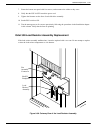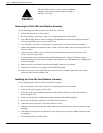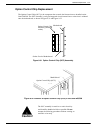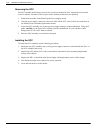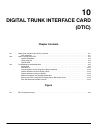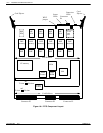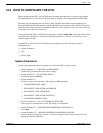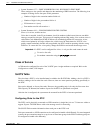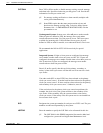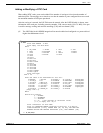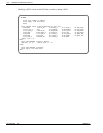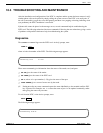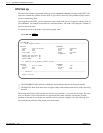
DTIC 10-3
Octel 200/300 S.4.1PB60019−01
10.2 HOW TO CONFIGURE THE DTIC
Before configuring the DTIC, the LSP Table must be added and configured at a password level higher
than Maintenance level. The correct LSP Table must be selected when configuring the SLOTS Table.
LSP tables are preconfigured and exist in the system. The LSP Table defines control parameters for
different DSP-based line/trunk interface cards and the DSP-based integration cards. Each LSP Table has
fields that define values for control parameters needed for correct operation of the card. These values are
downloaded to the card when it boots up.
You can list the LSP Tables in UPDATE by entering the command LIST LSP. If problems exist because
of an LSP Table configuration, information about these parameters is useful if it is necessary to call
technical support for help.
For the DTIC to operate, the Octel 200/300 must be configured correctly. The major items for
configuration are:
- System Parameters
- COS
- SLOTS Table
System Parameters
Several system parameters must be properly set to allow the DTIC to work correctly:
- System Parameter 3 — PBX TYPE and PBX MODEL.
Set the PBX type and model to the correct settings.
- System Parameter 9 — FLASH TIME (MSEC).
Set the flash time to 130 msec.
- System Parameter 13
Set the five parts of this parameter. The settings are PBX dependent.
- TRANSFER INITIATE CODE
- RECONNECT CODE AFTER NO-ANSWER
- RECONNECT CODE AFTER BUSY
- RECONNECT CODE AFTER FAST BUSY
- TRANSFER COMPLETE CODE
- System Parameter 51 — RS-232 INTEGRATED WITH PBX.
Does not have to be integrated to work. The setting is site dependent.
- System Parameter 77 — PBX PROVIDES MOMENTARY DISCONNECT.
Set to YES.
- System Parameter 117 — RINGBACKS BEFORE ANSWERING AX PORT.
Set to 3, 4,or5 for integrated systems or to 0 if not integrated. This setting is site specific and
depends on customer preference.



